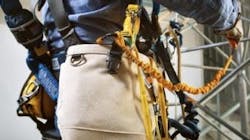Falling objects — including tools — are a hazard in the construction industry. They can strike workers or equipment on the way down if they aren’t secured, causing injury or death. Even a strong hard hat won’t be enough to prevent head injuries when a metal tool falls from a great height. Any type of falling object, including large power tools and small nuts/bolts, can be cause for concern. Gravity increases the force of the falling object to the point where it can penetrate a person’s safety equipment, almost like a speeding bullet.
What are tool tethers?
Tool tethers are designed to prevent objects from falling. They are used to attach various tools to an anchor point much like a fall arrest system for workers on elevated surfaces. The tether catches the tool if it slips out of the worker’s hand and prevents it from reaching the ground or floor below.
All tool tethers must be securely attached to the tool using a carabiner and D-ring. If the tool comes with a D-ring, it is considered “tether-ready.” Other attachment points include quick spin and quick ring attachments, D-ring cords, D-ring and quick-wrap tape, and tool cinch attachments. The tool should at least have a hole where the tether can attach; otherwise, it might not be safe to use when working at height.
The other end of the tether attaches to an anchor point, either on the worker’s body or the nearby structure. If the tool weighs over five pounds, it should be anchored off the body, such as the wall or railing. If the tool weighs five pounds or less, it can be attached to the worker’s tool belt, belt loops, holsters, or wristband. This helps the worker stay mobile in the field. If the tools need to be mounted off the body, they should be kept in a central location where the work is performed.
There are two types of tool tethers: rigid (or fixed-length) tool tethers and elastic (or extendable) tethers. Rigid tool tethers have a set length, and there is no fall arrest system to prevent the tool from swaying back and forth. Elastic tethers use shock absorption to slow the tool’s fall, which helps it come to a complete stop.
Both options prevent the tools from falling, but elastic tethers are typically the best choice for working at height. They make it easier for workers to collect fallen tools by limiting unnecessary movement. Heavy power tools can sway like pendulums if they have enough velocity, which can be dangerous in certain situations. The sudden jolt of a fall can also put pressure on fixed lanyards, making them more likely to fray.
What are the requirements for tethering tools?
Voluntary Standard 121-2018 from the International Safety Equipment Association (ISEA) outlines the best practices for tethering tools when working on elevated surfaces.
When choosing a tool tether, all attachments, lanyards, and anchors must be rated for the maximum weight of the tool in question. They should also be compatible with the tool. Read the manufacturer’s recommendations for tethering to select the right equipment.
A tether shouldn’t be any longer than what’s needed for the job. Crews should use the shortest possible tether to limit the distance between them and the tool. The further the tool falls, the more damage it can cause.
This equipment should also be tested on site before starting work. The lanyard should catch the tool during a fall without bumping into workers or surfaces. Tethering shouldn’t interfere with the tool’s functionality, including the locks, switches, and other controls. Workers can also practice recovering the tools after a fall to make sure they stay within reach.
Field workers should be trained in how to use this equipment and the importance of tethering tools. If management decides tethers are needed, signs should be installed on site to remind workers to use this equipment.
Workers should inspect the tethers before and after each shift to ensure they are safe to use. While this equipment tends to be durable with reinforced lanyards, the material can fray over time. D-rings may appear warped, dented, or rusted. Stretching the tether beyond the maximum reach reduces elasticity. All damaged equipment should be replaced immediately, and the damaged items should be taken out of service.
Workers should never keep tethers near moving parts or machinery, such as gears, blades, wheels, and belts.
Tethers, anchors, and attachments should be labeled and numbered. It’s best to store this equipment in a dry, room-temperature location to insulate it from damage.
Tool tethering should be included in the company’s safety records. Managers should document the condition, use, and maintenance of this equipment. If an accident should occur, the company can go back through these records to find out what went wrong and make changes to ensure it doesn’t happen again.
Tools can easily fall out of a person’s hands, especially if they are slippery or the worker can’t get a firm grip. But a falling tool doesn’t have to cause injury to others or bring the work to a halt. Workers should be able to quickly pick up the tool using the tether, so they can get back to work as soon as possible.
Tethering tools at height increases efficiency and reduces the risk of injury and structural damage.
About the Author
Rick Pedley
Rick Pedley, PK Safety’s president and CEO, joined the family business in 1979. PK Safety, a supplier of occupational safety and personal protective equipment, has been operating since 1947 and takes OSHA, ANSI, PPE, and CSA work safety equipment seriously. For more information, visit www.pksafety.com.
